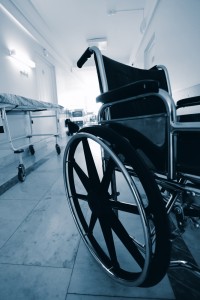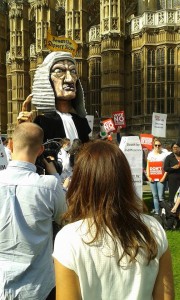 Of the fourth estate, Thomas Carlyle once vividly observed ‘Burke said there were three estates in parliament; but, in the reporters’ gallery yonder, there sat a fourth estate more important far than they all’. Now that clergy, nobles and commons are competing for celebrity status, all that remains of independent oversight of the publicity-seeking orders is the fourth. Yet as the Leveson report recommends compulsory state regulation of the press and greater concentration of power in the hands of politicians and their associates, we have recently been reminded, though it may have passed unnoticed, of the moral significance of press freedom.
Of the fourth estate, Thomas Carlyle once vividly observed ‘Burke said there were three estates in parliament; but, in the reporters’ gallery yonder, there sat a fourth estate more important far than they all’. Now that clergy, nobles and commons are competing for celebrity status, all that remains of independent oversight of the publicity-seeking orders is the fourth. Yet as the Leveson report recommends compulsory state regulation of the press and greater concentration of power in the hands of politicians and their associates, we have recently been reminded, though it may have passed unnoticed, of the moral significance of press freedom.
One needs no Sibylline insights but only an understanding of human nature to have observed the financial, political and medical interests that there are in institutionalising sedation-and-dehydration regimes, and then, inevitably, medical homicide. The age of austerity, targetised bed-clearing and a costly ageing population are reason enough for concern. Add to that the reality of human vice, mistake and ignorance and a background ethic that classifies the frail and vulnerable as ‘non-persons’ and we have every reason to doubt national sedation-and-dehydration strategies.
Dehumanising background ethic
The 1980s introduced into academic circles a fluctuating concept of human dignity with the severely disabled, sick, elderly and young being labelled philosophical ‘non-persons’. By 1993, the idea was given full expression in Airedale NHS Trust v Bland A.C. 789, where a severely disabled young man in a heart rending case was controversially described as ‘grotesquely alive’, having no meaningful life and no best interests. Food and fluids were withheld and a person who was not otherwise dying, died of dehydration. This reasoning, itself suggestive of Article 14 discrimination, was given credibility in the highest courts of the land and marked a judicial conceptual shift. The question had swung radically from whether treatment was futile, over-burdensome or over-expensive to the very different utilitarian question about whether a person’s very life was futile, over-burdensome or over-expensive.
Needless to say, some ideologues trumpeted their successes arguing that the case rang the death knell for the inviolability principle in medicine, the idea that all human beings, however disabled or incapacitated, have an inherent dignity. It demonstrated, so it was argued, that ethics was all about maximising higher-quality life after all. Once the dehumanisation of the incapacitated is entertained as a ground for undermining human rights, logic can offer no principled reason to oppose discrimination on the basis of disability, age, lower intelligence, psychological frailty, race, ethnicity, poverty, alcoholism or homelessness. Indeed it was the idea of a grotesque life with no meaning, worth or best interests that was famously applied to eliminate millions in that most secular and socially progressive of centuries, the twentieth.
Journalistic independence
The recent journalistic revelation, that the implementation of the Liverpool Care Pathway as the NHS National End of Life Care strategy in 2008 had been financially incentivised and implemented via pressure on healthcare workers’ very livelihood, emerged thanks to journalistic independence and genuine freethinking. Freedom of Information Act requests by journalist Simon Caldwell exposed the millions of pounds that had been paid to roll out the national strategy. But, personal reward was not the driver of this lethal engine. It is very likely that employment pressure was. Some hospital trusts had been paid these funds for ensuring that up to two-thirds of all deaths were Pathway deaths.
In the space of a few years, some health trusts had gone from 1% of all deaths being Pathway deaths to 30% of deaths being so. Weakness of will appears to dictate that those faced with loss or curtailment of their livelihood will do what is necessary to retain it. Given that the very employment of health professionals was being judged against the new Commissioning for Quality Innovation (CQUIN) Gold Standards Framework, staff compliance with the new regime was foreseeable. Financial incentives operated on staff themselves, not by way of remuneration, but by way of personal economic duress – hence the widespread compliance and reported staff satisfaction. Of course, death targets are unlike other targets in one important way: the former are potentially homicidal.
The Liverpool Care Pathway is undoubtedly intended as a palliative care regime at the end of life. Even its critics agree that certain of its recommendations may be useful and appropriate. Additionally, critics are aware that there are occasions when death may be a foreseen side effect of perfectly licit palliation whose primary ends are not homicidal at all. It is evident that treatment may be over-expensive, over-burdensome or simply futile. There is no suggestion that critics of the Pathway adhere irrationally to what is known in medical ethics as the error of vitalism, the commitment to excessive, extraordinary or futile treatment, or over-burdensome care at the end of life. As noted earlier, to ask whether treatment is futile, over-burdensome or over-expensive is very different to the discriminatory question about the futility, burden or expense of a frail and vulnerable patient.
Death Pathway’s critics
The sedation-dehydration aspect of the Pathway attracts much proper opposition. Doctors and families have found that those on the Pathway recovered when they intervened to take the patient off it. Senior medics have stepped forward, in the face of managerial opposition to argue that it is often impossible to know with certainty whether a person is imminently dying. One problem with the Pathway is that where a patient is misdiagnosed as terminal, the combination of morphine and dehydration has a self-fulfilling character and is likely to undermine a patient’s capacity. Persistent dehydration of even fit and healthy sedated patients will kill them. This was the difficulty highlighted by concerned medical professionals many years ago.
On top of this, lawyers, journalists and academics alike have serious concerns about the Pathway’s operation in the context of managerialised and incentivised death targets, healthcare cost-cutting, the reality of uncertain diagnosis and the pressure placed on healthcare professionals’ very livelihood if they are unable to achieve a gold standards death rate. By 2009, 560 care homes had rolled out the programme. The Winterbourne abuse revelations highlight how in the frightening locked, lonely and hidden world of the abusive care home, cruelty and finally homicide might well become habitual.
Death, it should be remembered, is a useful way of silencing a victim especially when he presents a threat or a financial reward to his oppressors. Bureaucrats and managers, full of the springtime of a new gold standards regulatory framework, are usually the last to own up to the recklessness presented by their own high-handed complicity.
The unveiling of the startling figures did little, at first, to temper the enthusiasm of those implementing the programme. The British Medical Journal and a good number of medical professionals proved themselves unwilling to consider the political and ethical implications of the emerging facts and figures as if by adopting an ostrich-like approach, flocking together and praising the Pathway ever more loudly, the putrid implications would evaporate. Once again the fourth estate was on hand to bear witness to the collective folly and conceit in print. The strategy’s discriminatory propensity to endanger our very lives, autonomy and dignity, given the political interests and employment pressure, was not something the Pathway’s implementers appeared to be able to comprehend. In spite of this and in view of the public crisis of confidence, an inquiry was ordered.
Independent inquiry
What is needed, however, is not a whitewash but an independent inquiry with all interests declared and data sets interrogated and collated. These will cover a time-series medical history of each anonymised patient on the Pathway, duration until death, information about interventions provided during the period, monthly raw data from each trust, hospice or care home, medical histories, removals from the Pathway, information about journals that were corrected once a patient recovered, demographic data, location information and an audit trail of all data management.
Further, a survey to allow collection of data about whether bodies were used for human tissue or body parts and information about family decision-making surrounding the use of the Pathway is indispensable. The relevant targets for each trust, hospice and care home should be supplied. The impact of not meeting targets needs analysis. This information has to be compared with use of the Pathway before the implementation of the 2008 national strategy.
Surveys of professional satisfaction with the Pathway directed primarily at those who have promoted it are now doing the rounds. These, however, will do little to allay public and professional concern. On the contrary, they merely highlight a conspicuous conflict of interest and suggest political complicity in an arguably lethal national programme. The fourth estate has put paid to public ignorance and there is now no substitute for a rigorous independent inquiry applying best practice. An exercise in self-justification in view of the facts and figures to hand is inexcusable.
The financial, political and medical interests in this incentivised national strategy speak for themselves.
This article first appeared in The Law Society Gazette.








Comments